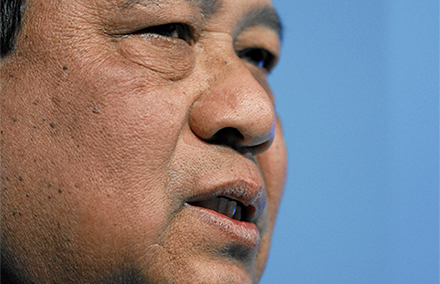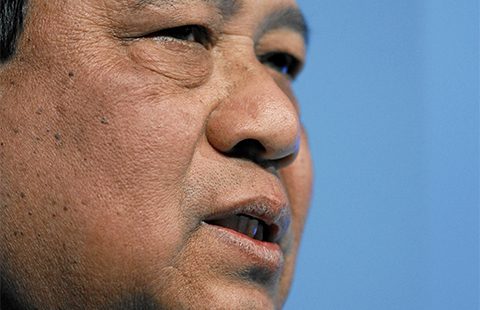
Photo by Moritz Hager.
Under ‘moderating president’ Susilo Bambang Yudhoyono, Indonesia’s democracy suffered no reverses – but it didn’t move forward either.
Much controversy surrounds how best to interpret Susilo Bambang Yudhoyono’s 10-year presidency and its legacy for Indonesia and its democracy.
It should not surprise us that assessments of the personal role played by Yudhoyono in Indonesia’s stabilisation and transformation have been highly divergent. While controversy is to be expected in assessments of any head of state, they have been unusually polarised in the case of Yudhoyono.
Internationally the president has been lauded as a visionary democratic leader. In 2014, for example, he was feted at UN headquarters in New York and praised by US President Barack Obama for his ‘leadership which has succeeded in leading Indonesia toward democratic transition’.
In contrast, large parts of Indonesia’s commentariat and the politically engaged public became increasingly disillusioned with the president, especially as the end of his second term neared. The most consistent line of criticism was that Yudhoyono was a peragu – a hesitator or vacillator – who took such care to avoid political controversy that he was rarely able to take decisive policy action.
Our fundamental proposition is that Susilo Bambang Yudhoyono might be thought of first and foremost as a moderating president. By this, we mean more than that Yudhoyono saw himself as politically moderate or centrist, though this was indeed an important part of his philosophy.
More fundamentally, Yudhoyono viewed himself as leading a polity and a society characterised by deep divisions, and he believed that his most important role was to moderate these divisions by mediating between the conflicting forces and interests to which they gave rise.
A fear of political turmoil and a determination to avoid it lay at the heart of Yudhoyono’s political philosophy. More than other compromise-wielding politicians in new and advanced democracies, Yudhoyono refrained from advancing his own ideas (if he had them) in a debate – instead, he saw his primary task as being to shepherd through an outcome in which everyone could ‘save face’.
In his descriptions of how policy was made under his government, he exhibited visible disdain for conflict but also pride in having routinely neutralised it.
There are many examples of Yudhoyono either failing to intervene decisively on a major issue or backing off from reform after encountering resistance from ministers, political parties, bureaucrats or interest groups.
For example, as highlighted in our new book, The Yudhoyono Presidency, there was the president’s remarkable failure, late in his second term, to set a course that would have protected the system of direct elections of local government heads from repeal.
Despite claiming that popular elections had been a high point of democratic performance under his presidency, he allowed members of his own government to develop plans for their abolition, and let his own party connive in a DPR (House of Representatives) decision to replace them with the previous system of indirect elections by local legislatures (a system that was notoriously corrupt).
Typically, Yudhoyono only took action to reverse this outcome when prompted to do so by popular outcry.
A similar example, was the president’s reluctance to vigorously defend the KPK (Corruption Eradication Commission) when it came under attack from elements in parliament and the police who were threatened by its anti-corruption drive.
Yudhoyono’s love of stability and concomitant reluctance to court conflict led him to position himself not so much as a political leader trying to persuade the elite and the public of his chosen course of action. Rather, he defined himself as Indonesia’s main political conciliator.
Hence, while many public figures criticised Yudhoyono for his inability to take strong stands on controversial issues, the president himself saw his predilection for the ‘middle way’ as a positive attribute. For Yudhoyono, who was acutely aware of the criticisms, it was crucial that an Indonesian president was not only a moderate, but a moderator.
What were the sources of Yudhoyono’s obsession with creating balance?
Any student of Indonesia’s modern history will immediately recognise strong traces of the political thinking that flourished under the New Order regime. An emphasis on harmony and balance, and an overriding commitment to stability and order were central features of the ‘Pancasila ideology’ promoted by that regime.
Despite his relatively humble origins, Yudhoyono became an important figure in Suharto’s New Order, marrying into an important New Order family and rising to near the top of the military; his experience of the transition from Suharto’s rule reinforced his predilection for political order.
All this is not to say Yudhoyono was undemocratic – on the contrary. His commitment to constitutional democracy was another core attribute of his political character. But observing the vestiges of New Order thinking in Yudhoyono’s outlook does help us locate him in key respects as a strongly conservative figure who did little to fundamentally challenge the power structures that existed in Indonesia when he came to office in 2004.
Indeed, during an interview we had with him in December 2014, when asked to name the greatest achievement of his presidency, Yudhoyono did not hesitate:
I would mention the consolidation of democracy. I would not say that it’s already perfect; we still have to perfect it. But I must say that in 2004 when I began as president, our democracy was not yet fully mature. It was not yet stable, it was not yet strong. At the very least, over the following 10 years we were able to safeguard the transition to democracy so that it experienced no setbacks, no changes of direction. As a result, I can say my successor can now actually further continue this democratic consolidation.
Of course, it is difficult to dispute that Yudhoyono presided over a period of remarkable democratic stability. Despite his New Order background, he preserved the democratic system he had inherited, motivated both by his political moderation and by his respect for majority opinion. By adopting such a posture, Yudhoyono helped Indonesia maintain democracy at a time when many countries that had become democratic in the 1980s and 1990s were sliding back towards authoritarianism.
But although Yudhoyono did not reverse Indonesia’s democratic trend, he also did nothing to help democratic attitudes, institutions and practices become so entrenched that we can now speak of Indonesia as a consolidated democracy. Democracy is not the only game in town in Indonesia. Despite the overall stability, the Yudhoyono presidency was also an era of missed opportunities to deepen democracy further.
A verdict of stagnation is supported by agencies that produce ratings of global democracy.
Freedom House, for example, upgraded Indonesia’s status from ‘partly free’ to ‘free’ in 2006, at the outset of Yudhoyono’s presidency, largely on the basis of the country’s implementation of direct elections of local government heads in 2005 (based on a 2004 law passed under the president’s predecessor Megawati Sukarnoputri).
At the end of Yudhoyono’s presidency in 2014, it relegated the country once again to ‘partly free’ status, mainly in response to the passage of a new law on social organisations that restricted freedom of association. While Indonesian democracy did not go into reverse during Yudhoyono’s tenure, neither did it make dramatic forward progress.
Democratic stability does not necessarily amount to democratic consolidation. While the decade of stable rule under Yudhoyono gave key democratic institutions time to bed down, it is far from clear that they became so strong that they were no longer under serious threat.
On the contrary, the near-death of direct elections of local government heads and attacks on the KPK demonstrate that the reverse was the case. The failure to more thoroughly reform institutions such as the police and the military, meanwhile, meant that reservoirs of authoritarian thinking remained powerful in key institutions, as they did in political parties.
These problems did not pose any immediate threat to the democratic system – precisely because of Yudhoyono’s personal commitment to democracy and his reluctance to oversee dramatic change – but they left open the real possibility of future piecemeal erosion.
Indeed, the sense of drift that evolved in Yudhoyono’s second term, and the public’s growing disillusionment with their irresolute leader, came close to propelling an outright authoritarian figure, Prabowo Subianto, into the presidential palace during the 2014 presidential election.
Overall then, the Yudhoyono years should not be interpreted only as a period of democratic stability; it was also a decade of democratic stagnation that actually exacerbated the long-term threats to Indonesia’s democratic consolidation.
Edward Aspinall, Marcus Mietzner and Dirk Tomsa are the editors of the newly launched book ‘The Yudhoyono Presidency: Indonesia’s Decade of Stability and Stagnation’. This article is an edited extract from their introduction to that volume.
Download the introduction and buy the book from the Institute for Southeast Asian Studies.
 Facebook
Facebook  Twitter
Twitter  Soundcloud
Soundcloud  Youtube
Youtube  Rss
Rss 